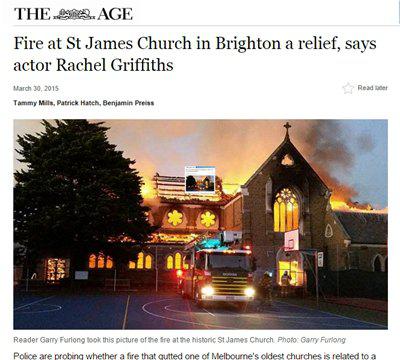|
The burning of a tainted church
By Andrew Hamilton
Two weeks ago one Melbourne church was burned down, and fires were started in two other churches. The media response to the fires focused on Rachael Griffiths' remark that she was happy to see her former parish church, St James, Gardenvale, in Melbourne, go up in flames because of the predatory behaviour of one of its parish priests. It also speculated whether the fire may have been lit by a victim of abuse. My own feelings about the destruction of St James were mixed. I was baptised and made my first confession and communion there. I was also an altar server, where I helped with the ritual and experimented in such pyrotechnics as putting gunpowder in the incense and making a blow torch out of the fly spray and candle, so mixing the boyhood dough of piety, responsibility and mischief that might later be baked into a living adult faith. Later I returned to the church to celebrate my first Mass and my mother's and father's funerals, as well as other family events. So the church is a place of remembered blessing. But more recently at the beginning of celebrations at St James I have felt bound to acknowledge that for some of those present this church would be a holy place, but for others a demonic place. And indeed for me, as for most former parishioners of my own and the next generation, it has become associated irredeemably with a parish priest who preyed on many children and bullied many older women. He redecorated the church in his own style, and devastated many lives in his own way. So the church is a place of remembered blasphemy. When Rachael Griffiths, my niece, spoke with her customary emotional intelligence, of her satisfaction at seeing the church burn, she echoed my own feelings and those of many of my generation and the next. To feel that way does not imply that we applaud people for burning down churches; nor do we believe it right generally to destroy places where evil things are done. And we sympathise with the present members of the congregation and the parish priest, who had nothing to do with the evil done in the church, in their loss and devastation. But to us St James came to speak most strongly, not of God's love, but of betrayal by one who claimed to represent God. It is a place to avoid. Many will criticise any expression of satisfaction at the burning of a church on the grounds it will encourage copy cat arson. But would not the suppression of the rage felt by so many members of a community who see the church as the symbol of abuse be more likely to lead to destructive actions? The Gardenvale church is not alone in being a locus of clerical abuse of children and of the devastation of the community. Members of other congregations will have known the lasting harm suffered by victims of abuse and their families, the alienation from the church by so many of their friends, their own sense of failure at having failed to notice and act on signs that later seemed patent, and the discomfort of priests and congregations as they tried to rebuild the parish. Business as usual in churches that have been violated engenders unease. But if not business as usual, then what? A little-used church law may suggest a better way. Canon 1211 allows for a church to be withdrawn temporarily from use after destructive actions that have scandalised Catholics, until the harm is repaired. It would be helpful if such interruption to the use of a church after the discovery of clerical abuse of children were introduced regularly. It is hard to imagine anything more damaging to the faith of a congregation than the realisation that clergy have used their position to abuse children, and that victims, their families and members of the congregation will continue to suffer the bitter consequences. The church building itself is inevitably seen as tainted by the abusive relationship between priest and parishioners and as needing to be purified. A break in the use of the church as a place of religious celebration would mark the break in relationships with God and among people caused by the abuse, and the dislocation in the meaning of church. The rituals of repair could then focus on the suffering of the victims of abuse, allow victims to take a leading part in the ritual if they wished, and result in the erection of a monument to record the abuse. As a symbolic action, of course, its force would depend on the evident determination of church leaders to ensure the accountability, transparency and protection that will keep children safe. The burning of a church offers further possibilities. The bare ruined walls of St James evoke those of the bombed Coventry Cathedral. When the Cathedral was rebuilt the walls, inscribed with the text 'Father forgive', were left as a monument. It would be a bold and noble gesture, exactly measured to the destruction done to the Catholic Church by priests' sexual abuse, to leave the ruined walls of St James as a shrine to the victims, a record of the evil that was done, and a pledge that never again will children be unprotected in the Catholic Church.
|
.
Any original material on these pages is copyright © BishopAccountability.org 2004. Reproduce freely with attribution.
